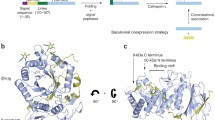Abstract
To approach the question of hyaluronan catabolism in tumours, we have selected the cancer cell line H460M, a highly metastatic cell line in the nude mouse. H460M cells release hyaluronidase in culture media at a high rate of 57 pU/cell/h, without producing hyaluronan. Hyaluronidase was measured in the H460M cell culture medium at the optimum pH 3.8, and was not found above pH 4.5, with the enzyme-linked sorbent assay technique and zymography. Tritiated hyaluronan was digested at pH 3.8 by cells or cell membranes as shown by gel permeation chromatography, but no activity was recorded at pH 7 with this technique. Hyaluronan was digested in culture medium by tumour slices, prepared from tumours developed in nude mice grafted with H460M cells, showing that hyaluronan could be digested in complex tissue at physiological pH. Culture of tumour slices with tritiated acetate resulted in the accumulation within 2 days of radioactive macromolecules in the culture medium. The radioactive macromolecular material was mostly digested by Streptomyces hyaluronidase, showing that hyaluronan was its main component and that hyaluronan synthesis occurred together with its digestion. These results demonstrate that the membrane-associated hyaluronidase of H460M cells can act in vivo, and that hyaluronan, which is synthesised by the tumour stroma, can be made soluble and reduced to a smaller size by tumour cells before being internalised and further digested.
Similar content being viewed by others
References
Bertrand P, Girard N, Duval C, D'Anjou J, Chauzy C, Menard J-F (1997) Increased hyaluronidase levels in breast tumor metastases. Int J Cancer 73: 327–331.
Cevallos MA, Navarro-Duque C, Varela-Julia M, Alagon AC (1992) Molecular mass determination and assay of venom hyaluronidases by sodium dodecyl sulphate–polyacrylamide gel electrophoresis. Toxicon 30: 925–930.
Corti C, Pratesi G, De Cesare M, Pellegrini R, Giardini R, Supino R, Zunino F (1996) Spontaneous lung metastases in a human lung tumor xenograft: a new experimental model. J Cancer Res Clin Oncol 122: 154–160.
Culty M, Shizari M, Thompson EW, Underhill C (1994) Binding and degradation of hyaluronan by human breast cancer cell lines expressing different forms of CD44: correlation with invasive potential. J Cell Physiol 160: 275–286.
Delpech B, Bertrand P, Maingonnat C, Girard N, Chauzy C (1995) Enzyme-linked hyaluronectin: a unique reagent for hyaluronan assay and tissue location and for hyaluronidase activity detection. Anal Biochem 229: 35–41
Jones MH, Davey PM, Aplin H, Affara NA (1995) Expression analysis, genomic structure, and mapping to 7q31 of the human sperm adhesion molecule gene SPAM1. Genomics 29: 796–800.
Liu D, Pearlman E, Diaconu E, Guo K, Mori H, Haqqi T, Markowitz S, Willson J, Sy M-S (1996) Expression of hyaluronidase by tumor cells induces angiogenesis in vivo. Proc Natl Acad Sci (USA) 9: 7832–7837.
Lokeshwar VB, Lokeshwar BL, Pham HT, Block NL (1996) Association of elevated levels of hyaluronidase, a matrix-degrading enzyme, with prostate cancer progression. Cancer Res 56: 651–657.
Maingonnat C, Victor R, Bertrand P, Courel M-N, Maunoury R, Delpech B (1999) Activation and inhibition of human cancer cell hyaluronidase. Anal Biochem 268: 30–34.
McGuire PG, Castellot JJ, Orkin RW(1987) Size-dependent hyaluronate degradation by cultured cells. J Cell Physiol 133: 267–276.
Montcourrier P, Silver I, Farnoud R, Bird I, Rochefort H (1997) Breast cancer cells have a high capacity to acidify extracellular milieu by a dual mechanism. Clin Exp Metastasis 15: 382–392.
Reissig JL, Strominger JL, Leloir LF (1955) A modified colorimetric method for the estimation of N-acetylamino sugars. J Biol Chem 217: 959–966.
Stair-Nawy S, Csoka AB, Stern R (1999) Hyaluronidase expression in human skin fibroblasts. Biochem Biophys Res Comm 266: 268–273.
Trochon V, Mabilat C, Bertrand P, Legrand Y, Smadja-Joffre F, Soria C, Delpech B, Lu H (1996) Evidence of involvement of CD44 in endothelial cell proliferation, migration and angiogenesis in vitro. Int J Cancer 66: 664–668.
Victor R, Maingonnat C, Chauzy C, Bertrand P, Olivier A, Maunoury R, Gioanni J, Delpech B (1997) Production d'hyaluronidase par les cellules canc´ereuses humaines en culture. CR Acad Sci (Paris), Life Sci 320: 805–810.
Victor R, Chauzy C, Gioanni J, D'anjou J, Girard N, Beuriot M, Stora de Novion H, Delpech B (1999) Human breast cancer metastasis formation in a nude mouse model. Studies of hyaluronidase, hyaluronan and hyaluronan-binding sites in metastatic cells. Int J Cancer 8: 77–83.
West DC, Shaw DM (1998) Tumour hyaluronan in relation to angiogenesis and metastasis. In: Laurent, TC ed. The Chemistry, Biology and Medical Applications of Hyaluronan and its Derivatives. London: Portland Press, pp. 227–233.
Author information
Authors and Affiliations
Rights and permissions
About this article
Cite this article
Delpech, B., Courel, MN., Maingonnat, C. et al. Hyaluronan Digestion and Synthesis in an Experimental Model of Metastatic Tumour. Histochem J 33, 553–558 (2001). https://doi.org/10.1023/A:1014908009409
Issue Date:
DOI: https://doi.org/10.1023/A:1014908009409




